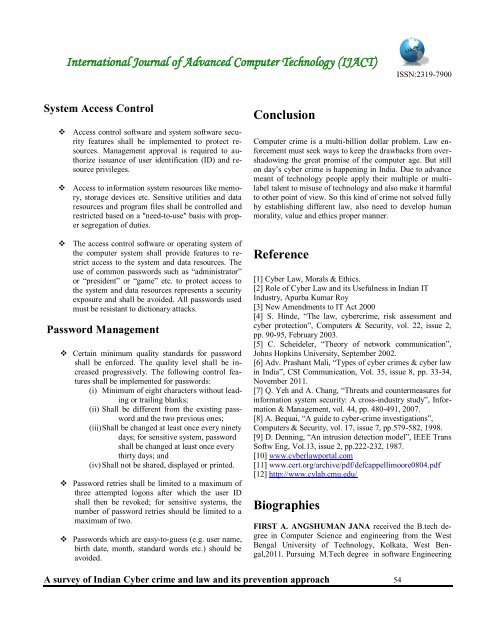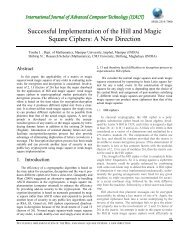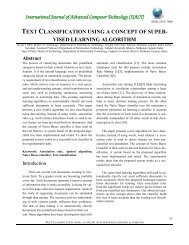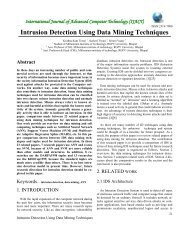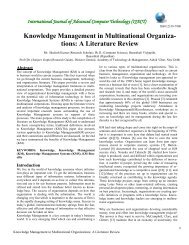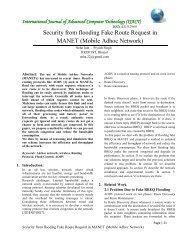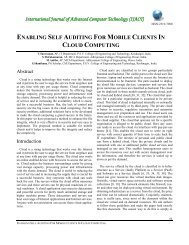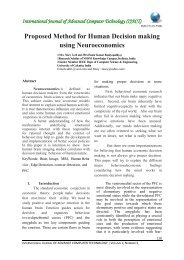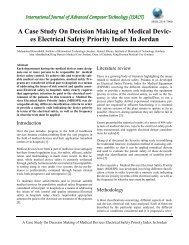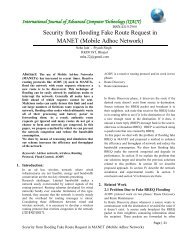A survey of Indian Cyber crime and law and its pre- vention approach
A survey of Indian Cyber crime and law and its pre- vention approach
A survey of Indian Cyber crime and law and its pre- vention approach
Create successful ePaper yourself
Turn your PDF publications into a flip-book with our unique Google optimized e-Paper software.
International Journal <strong>of</strong> Advanced Computer Technology (IJACT)ISSN:2319-7900System Access Control Access control s<strong>of</strong>tware <strong>and</strong> system s<strong>of</strong>tware securityfeatures shall be implemented to protect resources.Management approval is required to authorizeissuance <strong>of</strong> user identification (ID) <strong>and</strong> resourceprivileges. Access to information system resources like memory,storage devices etc. Sensitive utilities <strong>and</strong> dataresources <strong>and</strong> program files shall be controlled <strong>and</strong>restricted based on a "need-to-use" basis with propersegregation <strong>of</strong> duties. The access control s<strong>of</strong>tware or operating system <strong>of</strong>the computer system shall provide features to restrictaccess to the system <strong>and</strong> data resources. Theuse <strong>of</strong> common passwords such as “administrator”or “<strong>pre</strong>sident” or “game” etc. to protect access tothe system <strong>and</strong> data resources re<strong>pre</strong>sents a securityexposure <strong>and</strong> shall be avoided. All passwords usedmust be resistant to dictionary attacks.Password Management Certain minimum quality st<strong>and</strong>ards for passwordshall be enforced. The quality level shall be increasedprogressively. The following control featuresshall be implemented for passwords:(i) Minimum <strong>of</strong> eight characters without leadingor trailing blanks;(ii) Shall be different from the existing password<strong>and</strong> the two <strong>pre</strong>vious ones;(iii) Shall be changed at least once every ninetydays; for sensitive system, passwordshall be changed at least once everythirty days; <strong>and</strong>(iv) Shall not be shared, displayed or printed. Password retries shall be limited to a maximum <strong>of</strong>three attempted logons after which the user IDshall then be revoked; for sensitive systems, thenumber <strong>of</strong> password retries should be limited to amaximum <strong>of</strong> two. Passwords which are easy-to-guess (e.g. user name,birth date, month, st<strong>and</strong>ard words etc.) should beavoided.ConclusionComputer <strong>crime</strong> is a multi-billion dollar problem. Law enforcementmust seek ways to keep the drawbacks from overshadowingthe great promise <strong>of</strong> the computer age. But stillon day‟s cyber <strong>crime</strong> is happening in India. Due to advancemeant <strong>of</strong> technology people apply their multiple or multilabeltalent to misuse <strong>of</strong> technology <strong>and</strong> also make it harmfulto other point <strong>of</strong> view. So this kind <strong>of</strong> <strong>crime</strong> not solved fullyby establishing different <strong>law</strong>, also need to develop humanmorality, value <strong>and</strong> ethics proper manner.Reference[1] <strong>Cyber</strong> Law, Morals & Ethics.[2] Role <strong>of</strong> <strong>Cyber</strong> Law <strong>and</strong> <strong>its</strong> Usefulness in <strong>Indian</strong> ITIndustry, Apurba Kumar Roy[3] New Amendments to IT Act 2000[4] S. Hinde, “The <strong>law</strong>, cyber<strong>crime</strong>, risk assessment <strong>and</strong>cyber protection”, Computers & Security, vol. 22, issue 2,pp. 90-95, February 2003.[5] C. Scheideler, “Theory <strong>of</strong> network communication”,Johns Hopkins University, September 2002.[6] Adv. Prashant Mali, “Types <strong>of</strong> cyber <strong>crime</strong>s & cyber <strong>law</strong>in India”, CSI Communication, Vol. 35, issue 8, pp. 33-34,November 2011.[7] Q. Yeh <strong>and</strong> A. Chang, “Threats <strong>and</strong> countermeasures forinformation system security: A cross-industry study”, Information& Management, vol. 44, pp. 480-491, 2007.[8] A. Bequai, “A guide to cyber-<strong>crime</strong> investigations”,Computers & Security, vol. 17, issue 7, pp.579-582, 1998.[9] D. Denning, “An intrusion detection model”, IEEE TransS<strong>of</strong>tw Eng, Vol.13, issue 2, pp.222-232, 1987.[10] www.cyber<strong>law</strong>portal.com[11] www.cert.org/archive/pdf/defcappellimoore0804.pdf[12] http://www.cylab.cmu.edu/BiographiesFIRST A. ANGSHUMAN JANA received the B.tech degreein Computer Science <strong>and</strong> engineering from the WestBengal University <strong>of</strong> Technology, Kolkata, West Bengal,2011.Pursuing M.Tech degree in s<strong>of</strong>tware EngineeringA <strong>survey</strong> <strong>of</strong> <strong>Indian</strong> <strong>Cyber</strong> <strong>crime</strong> <strong>and</strong> <strong>law</strong> <strong>and</strong> <strong>its</strong> <strong>pre</strong><strong>vention</strong> <strong>approach</strong> 54


